AP Music Theory Masterlist
5.0(1)
Card Sorting
1/110
Earn XP
Description and Tags
Mr. Ornelas' Vocabulary
Study Analytics
Name | Mastery | Learn | Test | Matching | Spaced |
|---|
No study sessions yet.
111 Terms
1
New cards
Conjunct
Melody is stepwise

2
New cards
Disjunct
Melody uses skips and leaps

3
New cards
Tonic Function Chords
Chords 1 and 6
4
New cards
Tonic Prolongation Chords
Chords 3 and 6, OPTIONAL
5
New cards
Pre-Dominant Chords
Chords 2 and 4, OPTIONAL
6
New cards
Dominant Chords
Chords 5 and 7, 7 being rarely used
7
New cards
Anacrusis/Pick-up Note
Starts on an off-beats

8
New cards
Melodic Variation Techniques (MVT)
Inversion, Retrograde, Augmentation, Diminution
9
New cards
Inversion (MVT)
Upside down
10
New cards
Retrograde (MVT)
flip the first and last notes
11
New cards
Augmentation (MVT)
Extends, doubles the time
12
New cards
Diminution (MVT)
Shortens, halves the time
13
New cards
Retrograde Inversion (MVT)
Upside down and flipped first and last notes
14
New cards
Expansion (MVT)
Adds new material to the end
15
New cards
Mode Mixture/Borrowed Chords
Taking a chord from a different key (usually from a parallel key)
16
New cards
Mode Types
Ionian, Dorian, Phrygian, Lydian, Mixolydian, Aeolian and Locrian. (I Don't Particularly Like Modes A Lot
17
New cards
Ionian
Major (Same as major scale)
18
New cards
Dorian
Minor with a raised 6
19
New cards
Phrygian
Minor with a lowered 2
20
New cards
Lydian
Major with a raised 4
21
New cards
Mixolydian
Major with a lowered 7
22
New cards
Aeolian
Minor (Same as minor scale)
23
New cards
Locrian
Minor/Diminished with lowered 2 and 5
24
New cards
Melodic Motion Types
In the Bass and Soprano, Static, Contrary, Parallel, Oblique, Similar
25
New cards
Static Motion
The Soprano and Bass do not move
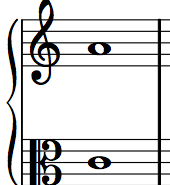
26
New cards
Parallel Motion
The Soprano and Bass move in exact intervals
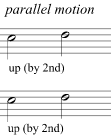
27
New cards
Oblique Motion
The Soprano or Bass does not move, the other voice part moves.
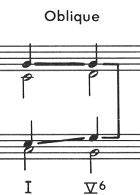
28
New cards
Contrary Motion
The Soprano and Bass move in opposite directions.
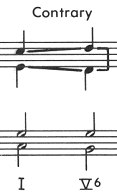
29
New cards
Similar Motion
The Soprano and Bass move the same way, not exact.
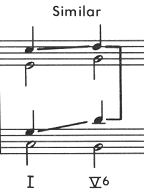
30
New cards
Texture
How the voices overlap; Monophony, Polyphonic, Homophony
31
New cards
Monophony Texture
One melodic line, similar to a chant
32
New cards
Polyphonic Texture
Different pitches and different rhythms
33
New cards
Homophony Texture
Same rhythms, different pitches. Similar to four-part writing.
34
New cards
Pizzicato
Plucked
35
New cards
Arco
Bowed
36
New cards
Counter Melody
A second melody that compliments the first melody.
37
New cards
Imitation
One voice part imitates another either in pitch, rhythm, or both.
38
New cards
Canon/Round
Exact Imitation
39
New cards
Fugue
A polyphonic style of counterpoint where the secondary voice enters in a different key. Made famous by Bach. Includes imitation.
40
New cards
Sequence
When a melodic figure repeats on a new pitch
41
New cards
Polyphonic
Having many voices or sounds
42
New cards
Pitch
The highness or lowness of a sound
43
New cards
Rhythm
Music's pattern in time.
44
New cards
Melody
A series of single tones that add up to a recognizable whole.
45
New cards
Harmony
The sound of two or more notes heard simultaneously.
46
New cards
Cadence
A two-chord progression at the end of a phrase; Half Cadence, Plagal Cadence, Perfect Authentic Cadence, Imperfect Authentic Cadence, Deceptive Cadence.
47
New cards
Half Cadence
Going from any chord, ending in the V chord.
48
New cards
Plagal Cadence
Going from the IV chord to the I chord.
49
New cards
Deceptive Cadence
Going from the V chord to the VI chord.
50
New cards
Perfect Authentic Cadence
Going from the V chord to the I chord, in root position, melody ends on the tonic, Soprano and Bass on the tonic.
51
New cards
Imperfect Authentic Cadence
Going from the V chord to the I chord. Missing of the requirements of a PAC.
52
New cards
Non-Chord Tones (NCT)
Tones not belonging to the chord; Passing Tone, Neighbor Tone, Escape Tone, Appoggiatura, Suspension, Anticipation, Retardation
53
New cards
Passing Tone (NCT)
Fills space between chord tones, approached and left by a step in the same direction.

54
New cards
Neighbor Tone (NCT)
Approached by a step in either direction, left by a step in the opposite direction.
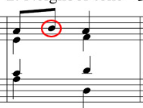
55
New cards
Escaped Tone (NCT)
Approached by a step, left by a leap
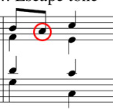
56
New cards
Appoggiatura (NCT)
Approached by a leap, left by a a step

57
New cards
Anticipation (NCT)
A note that belongs to the chord to follow. Approached by a step and resolves to the same note when the chord lands.
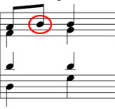
58
New cards
Suspension (NCT)
A note from the previous chord while all the others move to the following chord. Then is is resolved down by step on a weak beat of the new chord
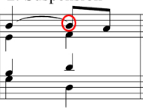
59
New cards
Retardation (NCT)
A suspension that resolves upward to a large interval (uncommon)
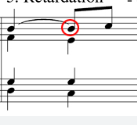
60
New cards
Leap
A fourth or higher
61
New cards
Skip
A third
62
New cards
Step
A second
63
New cards
Seventh Chord
A chord consisting of a root, 3rd, 5th, and 7th. Major, Minor, Dominant, Half Diminished, Fully Diminished
64
New cards
Major Seventh Chord (Maj7/M7)
A major triad stacked on a major triad. (Maj+Maj)
65
New cards
Dominant Seventh Chord (7)
A major triad stacked on a minor triad. (Maj+min)
66
New cards
Minor Seventh Chord (min.7/m7)
A minor triad stacked on a minor triad (min+min)
67
New cards
Half Diminished Seventh Chord (ø7)
A diminished triad stacked on a minor triad (dim+min)
68
New cards
Diminished Seventh Chord ( dim7/°7)
A diminished triad stacked on a diminished triad (dim+dim)
69
New cards
Major Triad (Maj.)
Major Third + Minor Third (Maj+min)
70
New cards
Minor Triad (min.)
Minor Third + Major Third (min+Maj)
71
New cards
Augmented Triad (Aug.)
Major Third + Major Third (Maj+Maj)
72
New cards
Diminished Triad (dim.)
Minor Third + Minor Third (min+min)
73
New cards
Root Position (Blank or 7)
A triad or seventh chord with the root in the bass
74
New cards
First Inversion Triad (6)
A triad with the third in the bass.
75
New cards
Second Inversion Triad (6/4)
A triad with the fifth in the bass.
76
New cards
First Inversion Seventh Chord (6/5)
A seventh chord with the third in the bass.
77
New cards
Second Inversion Seventh Chord (4/3)
A seventh chord with the fifth in the bass.
78
New cards
Third Inversion Seventh Chord (4/2)
A seventh chord with the seventh in the bass.
79
New cards
Motif
A short melodic idea that builds into a phrase and continually re-appears throughout the piece to help establish the theme.
80
New cards
Period
Two phrases combine. Parallel period, contrasting period, double period
81
New cards
Phrase
A unit of musical meter that has a complete musical sense of its own, with motifs combining to form melodies, periods and larger sections.
82
New cards
Parallel Period
Both phrases begin with similar material; second and last cadences are authentic
83
New cards
Contrasting Period
Period in which phrase beginnings are not similar; second and last cadences are authentic
84
New cards
Double Period
Four phrases in two pairs; the first three cadences are inconclusive, last cadence is an authentic cadence
85
New cards
Block Chord
Notes stacked vertically. All notes being played on the same beat. Contrary to an arpeggio
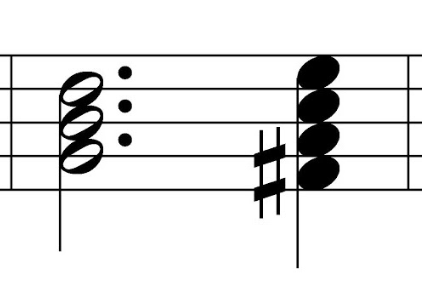
86
New cards
Broken Chord
Written horizontally, notes are played one after the other. Can be in any order

87
New cards
Arpeggio
Typically broken chord played in sequence in ascending and descending order. Is the extract same thing as broken chords
88
New cards
Alberti Bass
A left hand accompaniment pattern on a keyboard instrument that plays broken chords in a 1-5-3-5 order on hand. AKA Bottom Note, Top Note, Middle Note, Top Note

89
New cards
Walking Bass
A continuous bassline. Which includes chord tones and non-chord tones, usually stepwise tones.
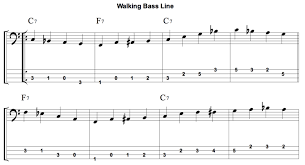
90
New cards
Pedal Point/Drone
A single note sustained over a long period of time.(Usually in bass or soprano.)
91
New cards
Picardy Third
In a piece written in minor, the final third is a major third.
92
New cards
Secondary Dominants
The five of a chord in a key. Example; A: V7/ii = F#7
93
New cards
Harmonic Rhythm
The rate at which the harmony changes
94
New cards
Harmonic Progression
A combination of chords in an ordered sequence
95
New cards
Tempo
The speed of the piece.
96
New cards
Syncopation
The note is on the off beat, preceded by a rest.
97
New cards
Classical Weak Beats
In 4/4 time, beats 2 and 4
98
New cards
Classical Strong Beats
In 4/4 time, beats 1 and 3
99
New cards
Hemiola
A rhythmic figure which includes 2 against 3
100
New cards
Melisma
In singing : one vowel over several different pitches